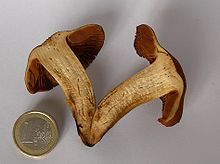Orange-foxed rough head
| Orange-foxed rough head | ||||||||||||
|---|---|---|---|---|---|---|---|---|---|---|---|---|

Orange fox head ( Cortinarius orellanus ) |
||||||||||||
| Systematics | ||||||||||||
|
||||||||||||
| Scientific name | ||||||||||||
| Cortinarius orellanus | ||||||||||||
| Fr. |
The Orangefuchsige Raukopf also Orangefuchsige Rauhkopf ( Cortinarius orellanus , Syn. : Dermocybe orellana ), also Orangefuchsiger veil Ling and Orangefuchsiger skin head called, is a poisonous mushroom species from the family of veil Ling relatives ( Cortinarius ) and the subgenus of rough heads .
features
The orange-foxed Roughhead forms fruit bodies that are divided into hat and stem, about 3–6 (–8) cm wide and about 10 cm high. Its hats are initially conical to bell-shaped and become increasingly flatter in the course of maturation, until they are finally convex and flattened to flatly hunched. The surface of the hat is matt, fibrous to finely flaky and dry, with a smooth, sharp, sometimes slightly torn edge; it is rich orange to copper or rust brown. The attached to broadly grown lamellae are ocher to rust-orange, later colored brown by the spore powder. The spore powder is brown. The stem is up to 15 mm thick, it is cylindrical, slightly tapered towards the base, it is of the same color as the hat or yellowish. The flesh is firm and yellowish, rust-brown under the hat skin. The odor of the mushroom is faintly radish-like.
ecology
The orange fox is a mycorrhizal fungus that lives together with various deciduous trees, more rarely with conifers. In Central Europe it can grow with beech , oak , hazelnut and chestnut , less often in coniferous forests. It grows preferentially in warm deciduous forests on acidic and basic soils, the fruiting bodies appear in Central Europe from summer to autumn.
distribution
The species occurs in Europe, Asia and North Africa.
meaning
The orange fox is one of the most dangerous poison mushrooms in Europe; its poison orellanin leads to the failure of the kidneys and other organs . It was not until the 1950s that Polish scientists discovered the effects of the fungus after mass poisoning; Since the symptoms only appear three to 14 days after consumption, the connection between the poisoning and the mushroom meal was not recognized for a long time. The type of poisoning now bears the name of the fungus: Orellanus syndrome . Intoxication with Rauköpfen are not very common, as it mushrooms not actually look very similar; nevertheless, they are sometimes confused with honey mushrooms or chanterelles . The orange fox was chosen by the German Society for Mycology as the mushroom of the year 2002 in order to point out the ecological importance of the mushroom and its toxicity.
swell
- Josef Breitenbach, Fred Kränzlin (Ed.): Mushrooms of Switzerland. Contribution to knowledge of the fungal flora in Switzerland. Volume 5: Agarics. Part 3: Cortinariaceae. Mykologia, Luzern 2000, ISBN 3-85604-050-1 .
- René Flammer, Egon Horak: Poison mushrooms - mushroom poisons. Mushroom poisoning. A reference work for doctors, pharmacists, biologists, mycologists, mushroom experts and mushroom pickers . Schwabe, Basel 2003, ISBN 3-7965-2008-1 .
- Egon Horak: Bolete and agaric mushrooms in Europe . 6th edition. Elsevier , Munich 2005, ISBN 3-8274-1478-4 .
- German Josef Krieglsteiner , Andreas Gminder (Hrsg.): Die Großpilze Baden-Württemberg . Volume 5: Mushrooms. Agarics III. Ulmer, Stuttgart 2010, ISBN 978-3-8001-3572-1 , p. 40.
- Hans E. Laux: The great cosmos mushroom guide. All edible mushrooms with their poisonous doppelgangers . Kosmos, Stuttgart 2001, ISBN 3-440-08457-4 .
- Rita Lüder: Basic course mushroom determination . A practical guide for beginners and advanced users. 2nd Edition. Quelle & Meyer, Wiebelsheim 2008, ISBN 3-494-01341-1 , p. 437 .
Web links
- Pictures in the mushroom gallery
- German Society for Mycology : Mushroom of the Year 2002 - Orangefuchsiger Rauhkopf, Cortinarius orellanus (Fr.) Fr.
- Schutzgemeinschaft Deutscher Wald : Nature of the year 2002 (PDF, 1.85 MB), page 3: Mushroom of the year - The orange-foxed rough head.
- The orange-foxed rough head - mushroom of the year 2002


